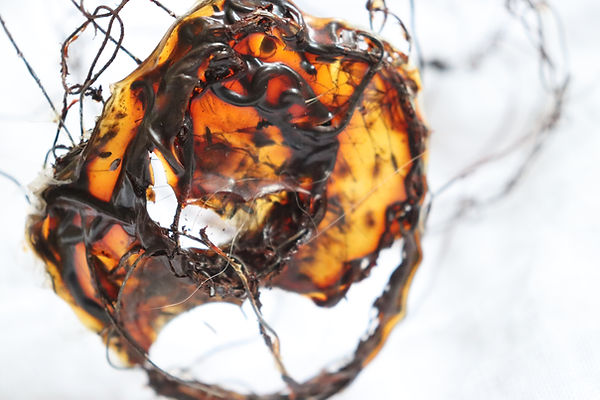





"We are all holobiont by birth" (Scott Gilbert)
A sympoietic intrarelationship such as that proposed by evolutionary developmental biologist Scott Gilbert’s theory of the holobiont argues that human pregnancy is “an amazing co-metabolic situation.” Haraway acknowledges the influence of Gilbert on her work. Gilbert asserts that “symbiosis is the way of life on earth; we are all holobionts by birth.” A holobiont is the coming together of a host with many other species which together form an ecological unit through symbiosis. He argues that “human pregnancy […] is an amazing co-metabolic situation […] “birth” is not the birth of a so-called individual. Birth is the continuation of the holobiont community.” Rethinking birth as the co-creative entanglement of the human with the non-human has nurtured a new form of art practice in which this ongoing exchange informs my process.
The phrase “on the wisp” or “on the straw” euphemistically referred to women giving birth on straw. This material has become both metaphor and matter in my art. Straw, with its healing properties for humans and non-humans, features in Ireland’s Straw Incorporation Measure (SIM), which pays farmers to enrich soil and reduce emissions. Traditionally seen as a by-product, straw here is reimagined as a regenerative force—medicine, soil support, and symbolic bridge between human and more-than-human worlds.
In my art practice, I create holobiont bowls by wrapping straw pulp around stones—intimate gestures that explore the reciprocal exchange between organic and mineral matter. More recently, I have begun incorporating additional materials into the straw pulp: paper ash, soil, flour, and dried rose petals. Each material carries symbolic and physical resonance. Ash introduces traces of loss and renewal; soil connects to cycles of nourishment and decay; flour recalls domesticity and sustenance. The inclusion of dried rose petals serves as both a personal and political marker—a quiet elegy for the rupture and erasure of human-nature relations, particularly within landscapes marked by violence and colonial extraction.
In addition to the holobiont bowls, I have been working with bioplastics made such as agar. I melt and shape this bioplastic, then dip fine metal wire into the mixture, allowing delicate films to form and solidify. Into these fragile skins, I tentatively embed dandelion seeds. The resulting structures are ephemeral and precarious, holding the tension between strength and vulnerability.
In the context of ongoing political violence and environmental degradation, these works speak to the strain placed on collaborative, life-generating processes. The metal wire introduces a rigidity that contrasts with the softness of the agar and the weightlessness of the dandelion seeds. This tension reflects the ways in which symbiotic relationships, between people, species, and environments, are stretched, manipulated, or severed under systems of control, colonization, and extraction.
Yet within this fragility, there is also persistence. The dandelion seed, a symbol of dispersal and regeneration, suggests the possibility of continued life, even in disrupted or hostile conditions. These bioplastic forms, like much of my work, hold space for both rupture and repair for an ethics of care that acknowledges damage without relinquishing the possibility of renewal.







